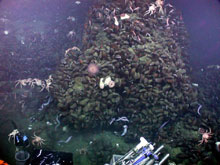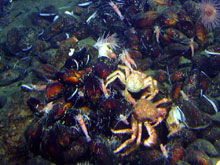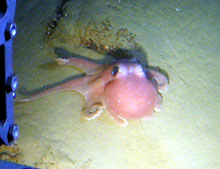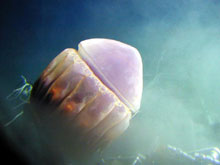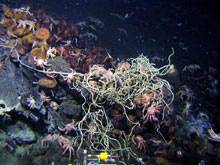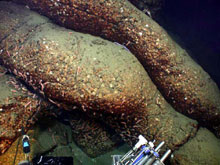
Spectacular tubes of lava covered in limpets wind their way down the slopes of the volcanic ridge. A swarm of shrimp are busy feeding near the base of one of the tubes. Click image for larger view.
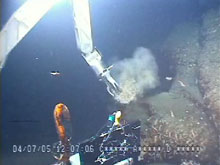
Pisces V stops to collect a rock sample from an outcrop of pillow lava with its dexterous manipulator arm. The pillows are covered with hydrothermal shrimp and dotted with either limpets or bivalves.
![]() Click
image to view a video. (Quicktime, 1.8 Mb)
Click
image to view a video. (Quicktime, 1.8 Mb)
Monowai Caldera - The Discovery of Mussel Ridge
April 12, 2005
Bob Embley
Co-Chief Scientist for the New Zealand American Submarine Ring of Fire Expedition
(Legs 1 and 2)
Geophysicist
NOAA Vents Program, Pacific Marine Environmental Laboratory – Newport,
Oregon
![]() A
brightly colored octopus encounters the submersible near a hydrothermal
vent at Monowai caldera (Quicktime, 1.8 Mb.)
A
brightly colored octopus encounters the submersible near a hydrothermal
vent at Monowai caldera (Quicktime, 1.8 Mb.)
![]() The
hydrothermal vents on Mussel Ridge at Monowai caldera (Quicktime, 1.9
Mb.)
The
hydrothermal vents on Mussel Ridge at Monowai caldera (Quicktime, 1.9
Mb.)
![]() Witness
the intense competition for food around a vent at Monowai caldera (Quicktime,
1.8 Mb.)
Witness
the intense competition for food around a vent at Monowai caldera (Quicktime,
1.8 Mb.)
We have now completed our first 4 dives with the Pisces V submersible at Monowai caldera. We expected to see vigorous hydrothermal venting on the southwestern side of the caldera because of the chemical-rich plumes discovered there in October 2004 by the New Zealand research vessel Tangaroa. As always happens in initial exploration, we were once again surprised at the nature of what we found. The first dive (p5-612) began to the north of the target site, a small ridge on the southwest side of the caldera. After traversing the seafloor for about 1 km upslope over old sedimented terrain occasionally broken by outcrops of pillow lava, Pisces V came up the west side of the ridge to an extraordinary sight at a depth of 1030 meters (~3400 feet). The seafloor was colonized by dense beds of mussels, in some places so thick that they completely covered the seafloor. Swarms of shrimp, crabs and pale white eel-like fish compete for “feeding space” on this living seafloor. This oasis extended for at least 300 meters (~1000 feet) along the crest of the ridge. In spite of the dense concentration of chemosynthetic mussels, the maximum temperature of the water seeping out of the seafloor was only a few degrees above the background temperature of the seawater (a chilly 4 deg C=39 deg F, but this is perfectly balmy for them!). The mussel colony probably depends on a low-level but extensive diffuse flow of mineral-rich warm water.
Part of exploring is that you never know what you will find during a dive. At Mussel Ridge, fortuitous encounters include a beautifully colored octopus and a strange-looking jellyfish.
A sampling device was lowered from the ship after the first dive and showed distinct plumes emanating from depths both at and below the crest of “Mussel Ridge”. Using this information, a search for deeper sites during dive p5-613 discovered several additional vents on the northern flank of the ridge. These deeper vents were much warmer (up to 56 deg C or ~135 degrees F), but appeared to be less extensive than the ones at the crest. Many of these vents were surrounded by clumps of bright yellow sulfur. There were also tubeworm colonies here that were not present at the top of Mussel Ridge.
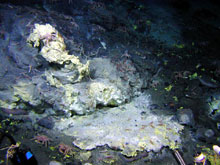
Sulfur (yellow) is associated with many of the vent sites at Mussel Ridge. These occurrences tell us that large amounts of sulfur gases are dissolved in the vent fluids. The small terrace in the foreground suggests the sulfur was molten (at least 119°C) before it solidified after contact with cold seawater. Click image for larger view.
The focus of the third dive at Monowai (p5-614) was to collect a suite of water and microbial samples at the various vent sites found on the first two dives. The tool used for this sampling is the Hydrothermal Fluid Sampler (HFS), especially designed for collecting a large number of water samples at multiple sites. The final dive at Mussel Ridge collected a large suite of biologic, geologic and chemical samples and discovered an additional, biologically distinct site on the small volcanic cone lying NW of Mussel Ridge.
The extensive biomass of Mussel Ridge was a surprise to us. This is another fascinating example of the complex interactions between the biological, chemical, and geological systems within volcanic arcs along the Submarine Ring of Fire. Tonight we're transiting to Macauley volcano, a large caldera with a young volcanic cone inside. We are all looking forward to this next phase of our explorations with the Pisces V team.
Sign up for the Ocean Explorer E-mail Update List.



























